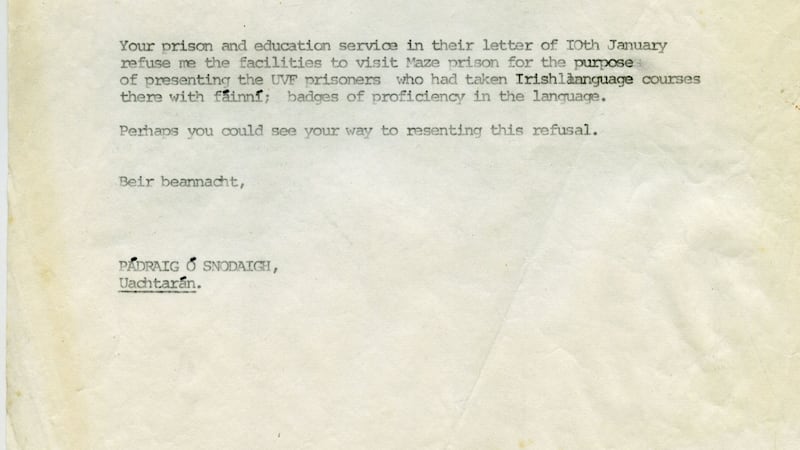Letters exchanged over Conradh na Gaeilge's request to present UVF prisoners with the Irish language badge of proficiency, An Fáinne, are among more than 600,000 items now available through an archive hosted by NUI Galway.
The collection of documents, posters, photographs and ephemera covering the more than 100-year history of Conradh na Gaeilge has been in development for more than two years.
The archive, which is divided into 46 series or categories, consists of hundreds of boxes of material and is one of the largest collections deposited with the university. It provides an insight into linguistic, cultural, social and political aspects of Irish history.

“From a social history point of view, it is an amazing collection,” said archivist Niamh Ní Charra. “When it arrived there was the equivalent of about 850 bankers’ boxes of material and there was no order on any of it. My first task was to literally go through every box, examine the material and make it safe.
Boxing a great catalyst for fostering good community relations, McGuigan says
‘I can’t sleep, I can’t eat’: Ukrainians in Ireland fear for relatives back home
Comedy duo the 2 Johnnies apologise for ‘offensive’ social media post
Councillors express ‘grave concerns’ about NMH move to St Vincent’s campus
“They were looking at how Irish was being used in every aspect of Irish life and, therefore, every aspect of Irish life is represented.”
Believed to be the largest and most complete collection assembled relating to the Irish language movement, the archive documents the role held by Conradh na Gaeilge during some of the most tumultuous periods in Irish history.
“The hardest job was not going down a rabbit hole myself, my job was to get it all arranged, catalogued and processed so that everyone else could go down the rabbit hole,” Ms Ní Charra said.
Materials include the minutes and programmes from Conradh na Gaeilge's ardfheiseanna going back to 1894. It also includes material from the years when the first president of Ireland, Dubhghlas de hÍde, was the organisation's president (1893-1915).
Cheques endorsed by Patrick Pearse and Terence MacSwiney also feature as do letters from Brendan Behan and Seán O'Casey relating to productions of their work in Irish.
The archive also includes material relating to music, sport, drama, religion, politics and events such as the annual Seachtain na Gaeilge campaign and Oireachtas competitions, which mark their respective 120th and 125th anniversaries this year.

But perhaps among the more surprising items for some will be an exchange of letters between then president of Conradh na Gaeilge Pádraig Ó Snodaigh and the Northern Ireland Office (NIO) in May 1978 over a request to meet in person UVF prisoners at the Maze prison. Mr Ó Snodaigh had been denied permission by prison authorities to present loyalist prisoners with an Fáinne Gaelach – a badge representing ability in the Irish language.
He subsequently wrote to Northern secretary Roy Mason asking him to rescind the decision. Citing "security considerations", the NIO turned down his request in a letter addressed to "Mr Patrick Snoddy".
A September 1981 letter from Maze prison assistant governor M G Murray to Albert Fry, president of Conradh na Gaeilge, explains the reason for cutting short a visit to an unnamed prisoner.
“Conversation between prisoner and visitors will be carried out in English unless the prisoner and visitors are not capable of conversing in English,” it says.
Ballot paper
Other articles include a ballot paper for the election of committee officers to the London Conradh na Gaeilge branch, 1915 which includes candidate Michael Collins. It also features photographs of demonstrations and posters used during campaigns for Irish language programming on TV and radio during which a number of activists were arrested and imprisoned over their refusal to pay the TV licence.
For John Walsh, associate professor of Irish at NUI Galway who led the acquisition of the collection, the archive is a valuable asset for scholars and public alike.
“It illustrates Conradh na Gaeilge’s pioneering work in various areas, for instance, the campaigns for radio and television services, all-Irish schools, a democratic Gaeltacht authority, the status of Irish in the EU and language rights on both sides of the Border.”
Meanwhile, National Museums NI has introduced a new project, Languages of Ulster, which will offer people an opportunity to explore the language traditions associated with Irish-English, Irish and Ulster Scots.
An educational trail called Cúl Trá-il – which derives its name from the Irish place name for Cultra (Baile Chúl Trá) – is a self-guided tour exploring the story of the Irish language through the places and people of the Ulster Folk Museum.
It is the first output of the Languages of Ulster project and work is under way to introduce an Ulster Scots trail.
The goal of the project is to show that language, in all its diversity, belongs to everyone and that people from all backgrounds and traditions have a stake in its future.
An illustrated booklet and smartphone app have been developed, both of which will be available in English and Irish. For more information visit nmni.com












